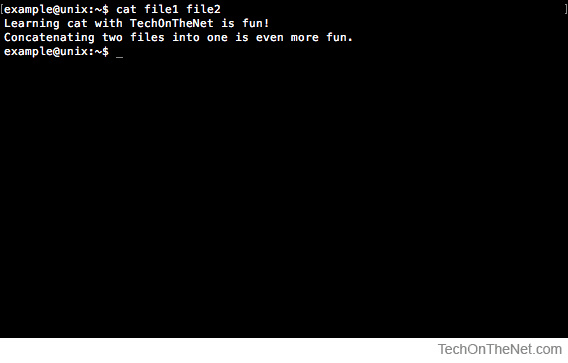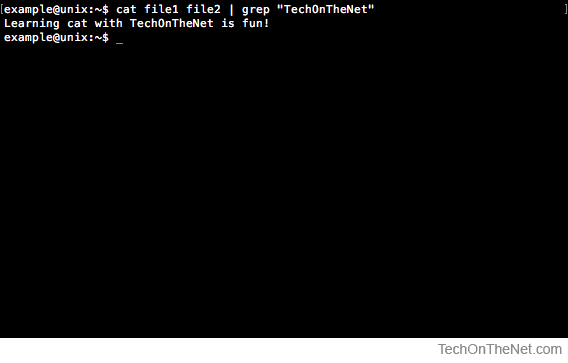- Команда cat Linux
- Команда cat
- Использование cat в Linux
- Выводы
- UNIX Basic commands: cat
- Syntax
- Parameters or Arguments
- Operators
- Applies To
- Type of Command
- Example — Using cat to output the contents of a file to the display
- Example — Using cat to output the contents of two files to the display
- Example — Using cat to redirect the contents of two files to another file
- Example — Using cat to append the contents of a file to the end of another file
- Example — Using cat to pipe the contents of a file into another command
Команда cat Linux
Команда cat — это одна из самых часто используемых команд Linux. Она часто применяется опытными пользователями во время работы с терминалом. С помощью этой команды можно очень просто посмотреть содержимое небольшого файла, склеить несколько файлов и многое другое.
Несмотря на то что утилита очень проста и решает только одну задачу в лучшем стиле Unix, она будет очень полезной. А знать о ее дополнительных возможностях вам точно не помешает. В этой статье будет рассмотрена команда cat linux, ее синтаксис, опции и возможности.
Команда cat
Название команды — это сокращения от слова catenate. По сути, задача команды cat очень проста — она читает данные из файла или стандартного ввода и выводит их на экран. Это все, чем занимается утилита. Но с помощью ее опций и операторов перенаправления вывода можно сделать очень многое. Сначала рассмотрим синтаксис утилиты:
$ cat опции файл1 файл2 .
Вы можете передать утилите несколько файлов и тогда их содержимое будет выведено поочередно, без разделителей. Опции позволяют очень сильно видоизменить вывод и сделать именно то, что вам нужно. Рассмотрим основные опции:
- -b — нумеровать только непустые строки;
- -E — показывать символ $ в конце каждой строки;
- -n — нумеровать все строки;
- -s — удалять пустые повторяющиеся строки;
- -T — отображать табуляции в виде ^I;
- -h — отобразить справку;
- -v — версия утилиты.
Это было все описание linux cat, которое вам следует знать, далее рассмотрим примеры cat linux.
Использование cat в Linux
Самое простое и очевидное действие, где используется команда cat linux — это просмотр содержимого файла, например:
Команда просто выведет все, что есть в файле. Чтобы вывести несколько файлов достаточно просто передать их в параметрах:
Как вы знаете, в большинстве команд Linux стандартный поток ввода можно обозначить с помощью символа «-«. Поэтому мы можем комбинировать вывод текста из файла, а также стандартного ввода:
Теперь перейдем к примерам с использованием ранее рассмотренных опций, чтобы нумеровать только непустые строки используйте:
Также вы можете нумеровать все строки в файле:
Опция -s позволяет удалить повторяющиеся пустые строки:
А с помощью -E можно сообщить утилите, что нужно отображать символ $ в конце каждой строки:
Если вы не передадите никакого файла в параметрах утилите, то она будет пытаться читать данные из стандартного ввода:
Для завершения записи нажмите Ctrl+D. Таким образом можно получить очень примитивный текстовый редактор — прочитаем ввод и перенаправим его вместо вывода на экран в файл:
Возможность объединения нескольких файлов не была бы настолько полезна, если бы нельзя было записать все в один:
cat file1 file2 > file3
$ cat file3
Вот, собственно, и все возможности команды cat, которые могут быть полезны для вас.
Выводы
В этой статье мы рассмотрели что представляет из себя команда cat linux и как ею пользоваться. Надеюсь, эта информация была полезной для вас. Если у вас остались вопросы, спрашивайте в комментариях!
Обнаружили ошибку в тексте? Сообщите мне об этом. Выделите текст с ошибкой и нажмите Ctrl+Enter.
UNIX Basic commands: cat
The cat command reads one or more files and prints their contents to standard output. Files are read and output in the order they appear in the command arguments.
Syntax
The syntax for the cat command is:
Parameters or Arguments
Some of the options available for the cat command are:
| Option | Description |
|---|---|
| -b | Starting at 1, number non-blank output lines. |
| -e | Display control and non-printing characters followed by a $ symbol at the end of each line. (May require the -v option) |
| -n | Starting at 1, number all output lines. |
| -t | Each tab will display as ^I and each form feed will display as ^L. (May require the -v option) |
| -u | Output is displayed unbuffered. |
| -v | Display control and non-printing characters. Control characters print as ^B for control-B. Non-ASCII characters with the high bit set display as «M-» followed by their lower 7-bit value. |
NOTE: While the options provided here work on most UNIX systems, some UNIX flavors may have changed their meanings or uses. If you experience an incompatibility with these options, please consult the cat manual page (see man command) on your system for a list of compatible options.
files A list of file names separated by spaces that cat will concatenate the contents of.
Operators
The following operators can be used with the cat command:
| Operator | Description |
|---|---|
| > | Redirect the output of the cat command to a file rather than standard output. The destination file will be created if it doesn’t exist and will be overwritten if it does. |
| >> | Append the output of the cat command to the end of an existing file. The destination file will be created if it doesn’t exist. |
| | | Send (or pipe) the output of the cat command into another command for further processing. |
Applies To
Type of Command
Example — Using cat to output the contents of a file to the display
In this example the file named file1 contains the text: Learning cat with TechOnTheNet is fun!
The following command uses the cat command to output the contents of file1 to the display.
In this screenshot, you can see that the contents of file1 are displayed as expected.
Example — Using cat to output the contents of two files to the display
Building on the previous example, we will use the cat command to output the contents of two files to the display.
For this example the file named file1 contains the text: Learning cat with TechOnTheNet is fun! and the file named file2 contains the text: Concatenating two files into one is even more fun.
The following command outputs the contents of the files file1 and file2 to the display.
In this screenshot, you can see that the contents of file1 is displayed first followed by the contents of file2.
Example — Using cat to redirect the contents of two files to another file
In this example we will use the cat command to redirect the contents of two files into another file.
The file named file1 contains the text: Learning cat with TechOnTheNet is fun! and the file named file2 contains the text: Concatenating two files into one is even more fun.
The following command redirects the contents of the files named file1 and file2 to the file named all.
To view the contents of the file named all we will also use the cat command as we did in the first example.
As we can see in the following screenshot, the contents of the files named file1 and file2 are sent into the file named all by the first command and the contents of the file all is output to the display by the second command.
Example — Using cat to append the contents of a file to the end of another file
In this example we will append the contents of one file to the end of another file.
For this example the file named file1 contains the text: Learning cat with TechOnTheNet is fun! and the file named file2 contains the text: Concatenating two files into one is even more fun.
We will use the following cat command to append the contents of the file file1 to the end of the file file2.
To view the contents of the file named file2 we will use the following cat command:
This screenshot shows the contents of file2 after the contents of file1 were appended to the end of file2.
Example — Using cat to pipe the contents of a file into another command
In this example we will use the cat command, the pipe operator and the grep command to send the contents of a file to the standard input of the grep command.
For this example the file named file1 contains the text: Learning cat with TechOnTheNet is fun! and the file named file2 contains the text: Concatenating two files into one is even more fun.
The following cat command pipes or sends the contents of the files file1 and file2 to the standard input of the grep command.
cat file1 file2 | grep "TechOnTheNet"
In this screenshot we can see that the contents of both file1 and file2 are sent into the grep command. The grep command filters the output displaying any lines that contain the string TechOnTheNet.
The line Learning cat with TechOnTheNet is fun! from the file named file1 contains the string TechOnTheNet so it is displayed by the grep command.
















